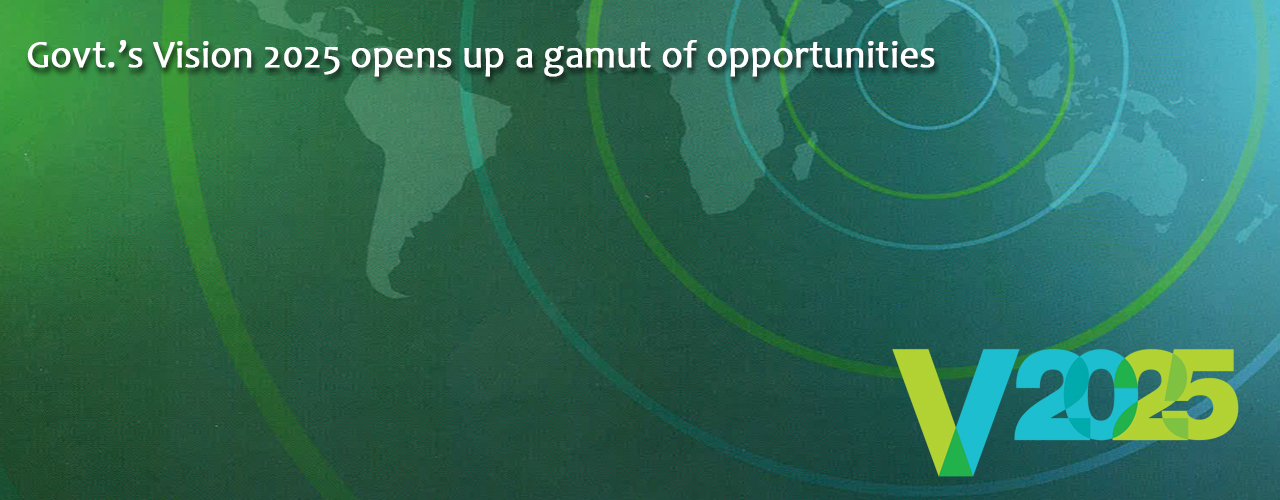Govt.’s Vision 2025 opens up a gamut of opportunities
The Government of Sri Lanka (GoSL) launching its economic policy framework titled, “V2025; A Country Enriched,” has pledged to make Sri Lanka a rich country by 2025.
The economic policy framework was launched by President Maithripala Sirisena, Prime Minister Ranil Wickremesinghe in the presence of a large gathering including former President Chandrika Kumaratunga, ministers, MPs, public officials and representatives of diplomatic missions.
The President and Pfremier chose not to make any official speeches but opted to answer questions from selected youth parliament members in an attempt to convey their reliance on the future generation and include their opinions in the larger policy programme.
While President Sirisena opted to concentrate more on the political challenges the country still had to overcome the PM did touch on economic reform. However, both leaders were somewhat ambiguous on details.
The President stressed on the importance of unity both amongst citizens and political parties, adding that remaining united on matters of importance will enable the country to achieve its goal of economic strength.
The Prime Minister stated that in areas where the country lacked technological know-how, that knowledge would have to be brought into the country from outside, going on to say that enhancing technology and innovation was imperative to sustained economic growth.
However, it must be noted that despite the lofty goal of laying out an economic framework for Sri Lanka, both the policy document and statements made by the two leaders were woefully lacking in essential details.
“Our vision is to make Sri Lanka a rich country by 2025. We will do so by transforming Sri Lanka into the hub of the Indian Ocean, with a knowledge-based, highly competitive, social market economy… We will position Sri Lanka as an export-oriented economic hub at the centre of the Indian Ocean…” read the section in the policy document titled, “The government’s economic vision.”
According to the section, “A 3-year economic delivery programme,”“Over the next three years, within the 2025 Vision, we will implement a comprehensive economic strategy to address constraints to growth. We will aim to raise per capita income to USD 5,000 per year, create one million new jobs, increase FDI to USD 5 billion per year and double exports to USD 20 billion per year. These intermediate targets lay the foundation for our Vision 2025: Sri Lanka to become an upper-middle income country.”
Without going into too much detail the government reiterated its need to boost investor confidence by implementing legal and policy reforms, expanding and diversifying exports, positioning Sri Lanka as a global logistics hub, developing the tourism industry, improving education infrastructure and services, improving healthcare, developing physical infrastructure, reforming land, labour and capital markets, expanding economic corridors, improving technology and expanding digitalisation, developing agriculture, improving public transport and concentration developing the Megapolis project.
“…We will maintain public investment at 5-6% of GDP for the period 2017-2020. We will use this for economic infrastructure development and for human resource development projects in education, healthcare, research and development (R&D) and vocational training instead of buildings as has been done in the past,” stated the document.
Explaining its plans to improve exports the document expounded, “We have formulated a new trade policy, along with an original National Export Strategy. These aim to create a more liberal, simple, transparent and predictable trade regime. These policy changes will attract more export-oriented FDI, improve trade logistics, make customs procedures transparent and quicker, and boost firms’ abilities to compete in global markets.”
It further stated that the GoSL intended to diversify into the export of services by taking “… advantage of the potential to export services in the fields of knowledge process outsourcing (KPO) and business process outsourcing (BPO), while moving towards cutting-edge technology and intellectual property rights (IPR)-based software product solutions.”
OSL TAKE:
Throughout the document the government of Sri Lanka refers to the need to form public private partnerships (PPP).
Under its tourism strategic plan it intends to “… encourage the private sector to attract tourist from new markets and to offer new products.”
With regard to land reform, the government states that it “… will review key legislations and make necessary amendments to free up land for economic activities…” and establish major economic development zones in various locations around the country.
“… The government will take steps to increase state university enrolment while continuing with non-state universities with a strong monitoring mechanism to ensure that standards are maintained. A suggested PPP model is to have international universities in Sri Lanka, as these will cater to our knowledge economy, improve university driven R&D, and promote links to global industries for practical training. An interest-free loan scheme for students not accommodated by state universities, to enable access to non-state universities has already been initiated,” states the document in relation to increasing access to tertiary education.
The government has stated its eagerness to partner with foreign parties with regard to healthcare development referring to collaborations with foreign research institutes for disease management and cure.
The document makes reference to several PPPs in infrastructure development (LNG projects, desalination plant, Kerawalapitiya etc.), public transport development (LRT system etc.) and the Megapolis project.
“The Government will encourage the Build-Operate-Transfer model in small and medium scale infrastructure projects across the country. We will empower the private sector to build small and medium infrastructure projects, which could in turn be leased out to the Government with the intention to transfer eventually. These projects could be in education, health and other sectors where Government expenditure is high for infrastructure requirements. The capital saved on construction by the Government will be invested in improving technology, advanced knowledge and human resource development,” the document reads.
As can be seen by the government’s objectives, a whole gamut of opportunities exists for enterprising and interested individuals.
| Article Code : | VBS/AT/07092017/Z_5 |

